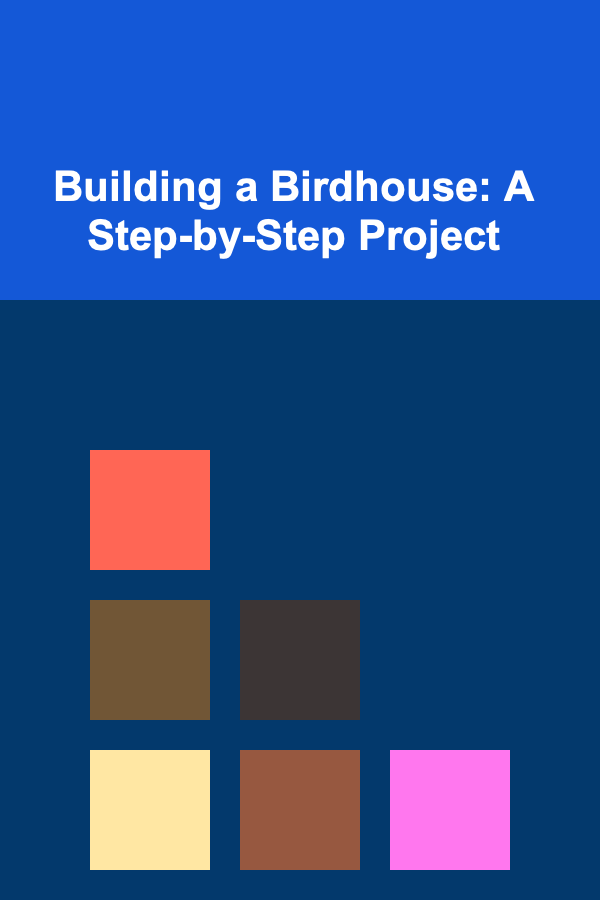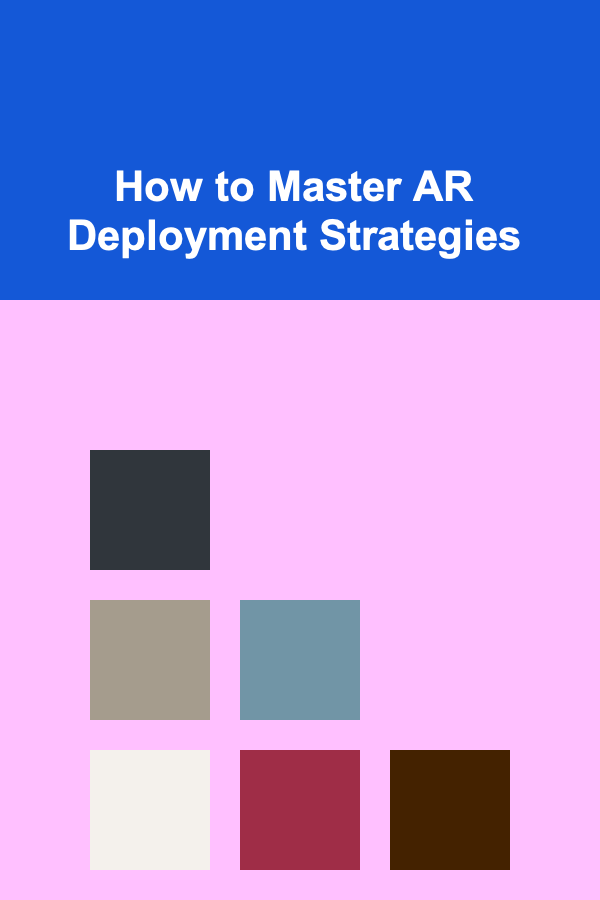
Building a Birdhouse: A Step-by-Step Project
ebook include PDF & Audio bundle (Micro Guide)
$12.99$9.99
Limited Time Offer! Order within the next:

Building a birdhouse is a fantastic DIY project for anyone interested in woodworking, gardening, or providing a safe haven for local wildlife. Birdhouses not only add charm to your garden or backyard but also attract birds that can help control pests and enhance biodiversity. In this guide, we will take you through the process of creating a birdhouse from start to finish. Whether you are an experienced woodworker or a novice, this project is simple and rewarding.
Materials and Tools Needed
Before we begin, let's gather all the necessary materials and tools.
Materials:
- Wood (preferably untreated cedar, pine, or redwood): The dimensions will depend on the bird species you're targeting. Typically, you will need:
- 1 wooden plank for the back, front, and side walls
- 1 piece of wood for the roof
- 1 piece for the floor
- Screws or nails: For assembly
- Hinges (optional, for a cleanable birdhouse)
- Wood glue (optional, for added strength)
- Sandpaper or sanding block: To smooth edges and surfaces
- Drill with various bits: For making holes for screws and a hole for the bird's entrance
- Paint or wood finish (optional, but should be non-toxic if used)
- Measuring tape and pencil: For marking cuts
- Saw (a handsaw or circular saw will work)
- Safety glasses and ear protection
Types of Wood:
It is important to use natural, untreated wood for the birdhouse. Wood that is chemically treated can be harmful to birds. Softwoods like pine, cedar, or redwood are ideal choices for this project as they are durable and weather-resistant.
Step 1: Planning the Design
Before you begin cutting wood, it's essential to plan out the dimensions of the birdhouse. Different bird species require different sizes of houses, so make sure to choose a design that matches your target species.
Common Birdhouse Dimensions:
- Eastern Bluebird: The entrance hole should be about 1.5 inches in diameter, and the box should be 5x5 inches for the base, with a height of 10-12 inches.
- Chickadee: A 1.25-inch entrance hole, with a 4x4-inch base and a height of 8-10 inches.
- Wren: Entrance hole of 1 inch, with a 4x4-inch base and a height of 8 inches.
For this guide, we'll assume you are building a general-purpose birdhouse that can attract a variety of small birds. You can always adjust the design based on specific bird species that frequent your area.
Step 2: Cutting the Wood Pieces
Now that you have a plan, it's time to start cutting the wood. Here's a breakdown of the pieces you'll need to cut:
1. Back Wall:
- Dimensions: 10-12 inches tall and 5-6 inches wide (adjust based on your design).
- Cut a straight piece from your plank of wood to serve as the back wall of the birdhouse.
2. Front Wall:
- Dimensions: Same as the back wall, but with an entrance hole. The hole should be about 1.25 inches for smaller birds like chickadees or 1.5 inches for bluebirds. Mark the hole in the center of the front wall, and drill it out carefully.
3. Side Walls:
- Dimensions: Typically 8-10 inches tall and 4-5 inches wide. Cut two identical pieces for the left and right sides of the birdhouse.
4. Floor Piece:
- Dimensions: 4x4 inches for a general-purpose birdhouse. Ensure that the floor fits snugly inside the base of the walls.
5. Roof Piece:
- Dimensions: A bit larger than the birdhouse itself, to extend over the edges for weather protection. It should be around 7x7 inches for a general-purpose birdhouse.
6. Floor Ventilation Holes (Optional):
- Drill a couple of small holes (about 1/4 inch) in the floor piece to allow for proper drainage. This ensures the birdhouse doesn't get too damp or moldy inside.
Using your saw, carefully cut all the pieces to the required dimensions. Make sure to wear your safety glasses to protect your eyes from flying wood debris and ear protection if you're using power tools.
Step 3: Sanding the Edges
After cutting all the pieces, take some sandpaper or a sanding block to smooth out the edges of each piece. Sanding is important to prevent sharp edges that could harm the birds. Make sure to smooth out the entrance hole as well, so the birds can easily enter and exit the birdhouse.
Tip:
Use a fine-grit sandpaper to get a smooth finish. You don't want any rough spots that could hurt the birds.
Step 4: Assembling the Birdhouse
Now that you have all the pieces prepared, it's time to assemble the birdhouse. Follow these steps:
1. Attach the Side Walls to the Back Wall:
- Position the two side walls along the edges of the back wall. Use screws or nails to attach the side walls to the back wall, making sure they are perpendicular and secure.
2. Attach the Floor:
- Place the floor piece inside the side walls, flush against the bottom edge. Secure it with screws or nails, ensuring it is firmly attached.
3. Attach the Front Wall:
- Line up the front wall with the side walls and floor, and attach it using screws or nails. Make sure the entrance hole is facing forward.
4. Install the Roof:
- Position the roof piece so that it extends over the edges of the birdhouse to provide shelter. Attach the roof with screws or nails, ensuring it is secured tightly.
If you prefer a hinged roof for easy cleaning, you can attach one side of the roof with a small hinge, making sure it opens easily without falling off.
Tip:
For added durability, you can use wood glue in addition to screws or nails to secure the pieces. This will strengthen the birdhouse and prevent it from falling apart over time.
Step 5: Painting or Finishing (Optional)
While it's not strictly necessary, you can paint or stain the birdhouse to add a decorative touch. If you decide to paint it, use non-toxic paint or wood finish that is safe for birds. Be sure to avoid any harsh chemicals or bright colors that might deter birds from nesting.
Step-by-Step:
- Apply a coat of non-toxic wood finish or paint using a brush or spray can.
- Allow the birdhouse to dry completely before moving it to its final location.
- If you use paint, let the birdhouse cure for several days to ensure the paint is dry and odor-free.
Tip:
Avoid painting the interior of the birdhouse, as birds prefer natural wood.
Step 6: Mounting the Birdhouse
Once your birdhouse is assembled and painted, it's time to mount it. The location of the birdhouse is crucial for attracting birds, so consider these factors:
- Height: Most birdhouses should be mounted at least 5-10 feet above the ground to protect the birds from predators.
- Location: Place the birdhouse in a quiet, sheltered area with some protection from the elements. Birds prefer areas with trees, shrubs, or other forms of natural cover nearby.
- Direction: Position the entrance hole away from prevailing winds and direct sunlight. A north or east-facing entrance is ideal.
You can mount the birdhouse on a pole, tree, or even a fence. Use strong screws or brackets to secure it in place, ensuring it won't sway in the wind.
Tip:
If you're mounting on a tree, be careful not to place the birdhouse too low, as it could attract predators.
Step 7: Enjoy Your New Avian Neighbors
Now that your birdhouse is up, it's time to sit back and wait for your new feathered friends to move in. Be patient -- it may take some time for birds to discover the house. In the meantime, you can observe the wildlife around your garden and enjoy the process of birdwatching.
Tip:
Keep an eye on the birdhouse, especially during nesting season. If you notice any damage, repair it promptly to keep the birds safe.
Conclusion
Building a birdhouse is a rewarding project that connects you to nature while providing a safe and comfortable home for local birds. With just a few materials, simple tools, and a little patience, you can create a beautiful and functional birdhouse that will attract a variety of birds to your yard. Whether you build one for fun or to encourage more wildlife, this DIY project will bring the beauty of nature to your doorstep. Happy birdwatching!

Automating Passive Income with Deep Learning Solutions
Read More
Avoiding Unnecessary Subscriptions: A Step-by-Step Guide to Cutting Costs
Read More
Essential Tips for Pet Care on a Budget: Keep Your Pet Happy Without Breaking the Bank
Read More
How to Use Financial Independence to Shape Your Life Choices
Read More
How to Master AR Deployment Strategies
Read More
How to Discover Children's Books That Inspire
Read MoreOther Products

Automating Passive Income with Deep Learning Solutions
Read More
Avoiding Unnecessary Subscriptions: A Step-by-Step Guide to Cutting Costs
Read More
Essential Tips for Pet Care on a Budget: Keep Your Pet Happy Without Breaking the Bank
Read More
How to Use Financial Independence to Shape Your Life Choices
Read More
How to Master AR Deployment Strategies
Read More